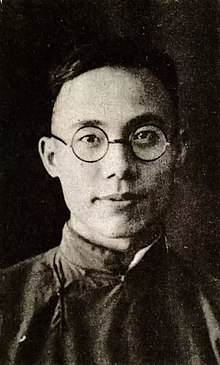Fang Ganmin | |
|---|---|
| 方幹民 | |
 Fang Ganmin, c. 1930 | |
| Born | 15 February 1906 |
| Died | 21 January 1984 (aged 77) |
| Nationality | Chinese |
| Known for | Painting, drawing, sculpture |
| Movement | Cubism, Chinese Modernism |
| Spouse | Su Ailan (蘇愛蘭) |
| Fang Ganmin | |||
|---|---|---|---|
| Traditional Chinese | 方幹民 | ||
| Simplified Chinese | 方干民 | ||
| |||
Fang Ganmin (simplified Chinese: 方干民; traditional Chinese: 方幹民; 15 February 1906 - January 1984) was a Chinese French-trained painter, sculptor and educator, who was educated in Paris and spent most of his adult life in China. Regarded as one of the pioneers of Chinese oil painting, Fang was born in the Wenling county, Zhejiang province. He began studying painting in 1924 and went to Paris in 1925, enrolling in the École nationale supérieure des Beaux-Arts, making him one of the first-generation Chinese painters to study abroad in France. Upon returning to China, he taught at the National Arts Academy, Hangzhou, becoming a professor at the Western Painting Department.[1][2] During the Cultural Revolution, Fang was shamed and tortured by the Red Guards, and his works were destroyed. He died in 1984. His students include Zao Wou-Ki, Chu Teh-Chun[3] and Wu Guanzhong.[4]

- ^ von Sarah Khan (27 March 2009). Globalisierende Kunstmärkte: Das Phänomen Kunst im 21. Jahrhundert aus globaler Perspektive. Zum Ende des hegemonialen Anspruchs des westlichen Kunstsystems und zum Anfang einer post-globalen Kultur. LIT VERLAG. pp. 113, 115, 116.
- ^ Sullivan, Michael (1998). Art and Artists of Twentieth-century China. University of California Press. pp. 40, 301.
- ^ "水天中:朱德群和他的画_画廊新闻_雅昌新闻". news.artron.net. Retrieved 2018-02-02.
- ^ Yasuko FURUICHI, 古市保子 (2006). Cubism in Asia: Unbounded Dialogues -- Report. Japan Foundation (Tokyo, Japan). pp. Presentation 2 of Session 1, Presentation 1 of Session 3.